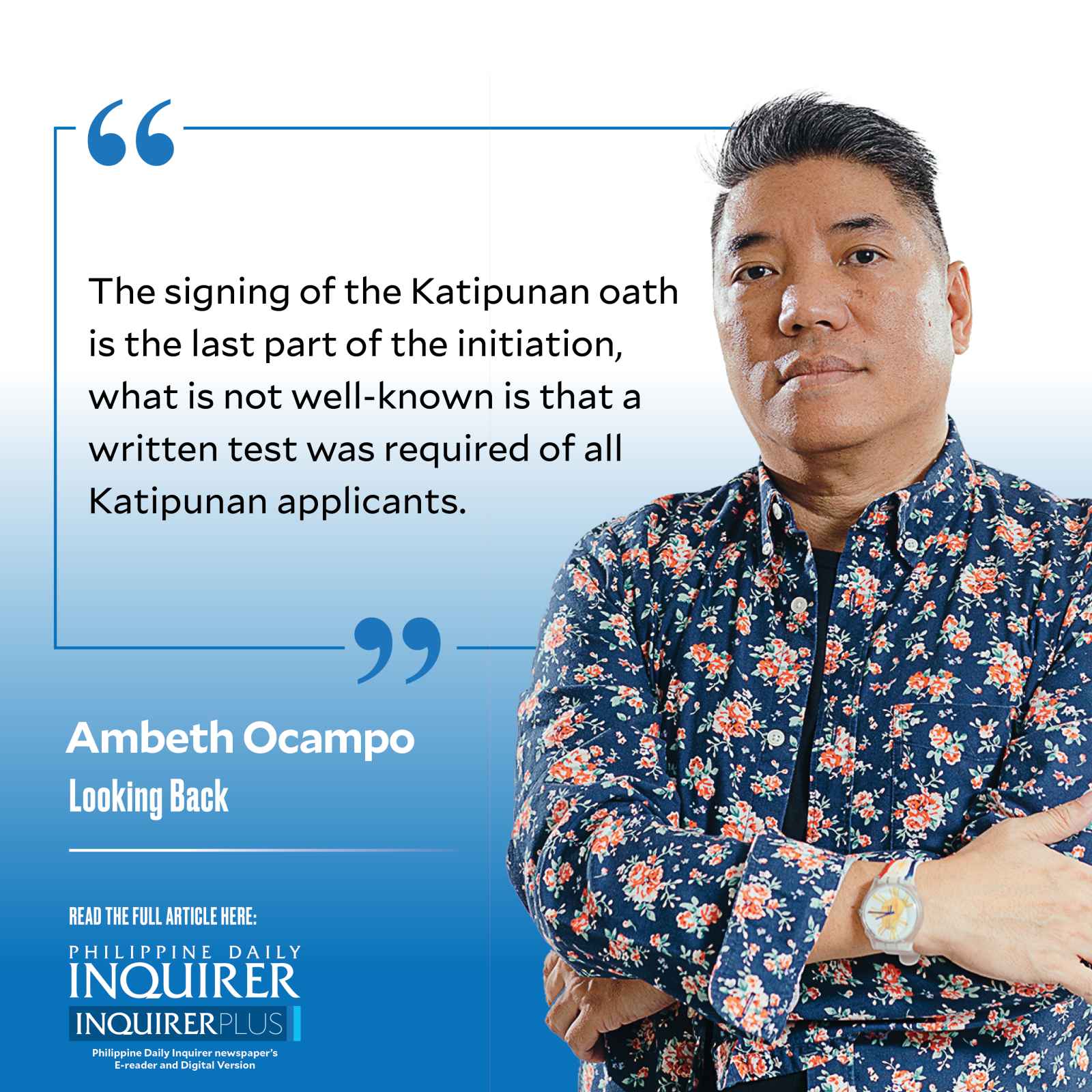Katipunan exam
I remember a news report from 1997, when a vendor in Tutuban station was asked for the significance of the Bonifacio monument erected in the hero’s birthplace. Scratching his head, the vendor apologized, “Sorry, I don’t know. I’m not from here.” The year 1997 marked the centennial of Andres Bonifacio’s execution in Maragondon, and here was a Filipino, literally in the shadow of the Bonifacio monument, who did not know of the Katipunan and the 1896 Philippine Revolution against Spain. It did not help that the Bonifacio monument in Tutuban is unique. Instead of the iconic bolo, properly called “sangbartolome,” Bonifacio holds a quill, a symbol associated more with Jose Rizal. Unlike most depictions of Bonifacio, angrily shouting the P-word at the enemy, the one in Tutuban has him earnestly writing, without a desk and chair, in a very uncomfortable position!
Artistic depictions of Jose Rizal: poet, novelist, and writer have him with a quill. Rizal did not use a quill, he used a pen with a metal nib and a wood shaft. In art, Rizal is sometimes depicted writing on a desk, with a solitary oil lamp for lighting. The lamp, not a candle, is a reference to Rizal’s childhood, when his mother read him the story of the “Moth and the Flame,” a tale similar to Icarus from Greek mythology, a man whose curiosity led to his death and, literal, downfall.
Article continues after this advertisementAraling Panlipunan teaches us that the pen (Rizal’s quill) is mightier than the sword (Bonifacio’s bolo). Should it always be this way? Why do we pit our national heroes against each other like gamecocks at a pintakasi? Quill vs bolo. Reform vs revolution. Black suit and bowler vs white camisa de chino and red kundiman pants. Postgraduate education abroad vs the equivalent of today’s Grade 5. A European-trained medical doctor vs a lowly stock clerk (bodeguero). Some teachers encourage aimless debate and fall short of resolution by asking students to choose between Rizal and Bonifacio. That’s like comparing sinigang with tom yum. Why choose one, when we can have both Rizal AND Bonifacio?
I have seen and heard of high school “Noli me Tangere” plays and skits where Crisostomo Ibarra, garbed in black suit and bowler, is made to personify Rizal, while Elias, in white camisa and red pants, is Bonifacio. Ibarra and Elias are in a banca, whether the country is better off with reform or revolution. In 1887, when the “Noli” was published in Berlin, Rizal and Bonifacio were strangers to each other. They met face to face on July 3, 1892, in Tondo during the founding of La Liga Filipina.
The Bonifacio monument in Tutuban is not a depiction of the hero who translated Rizal’s valedictory poem (“Mi último adiós”) from the original Spanish to Tagalog. Neither is it a reference to Bonifacio composing “Pag-ibig sa Tinubuang Lupa.” Bonifacio in Tutuban is signing his Katipunan oath with a quill in his right hand, using blood drawn from an incision on his left arm as ink. Other depictions of the Katipunan initiation rites show the other props: a skull used as a candle holder, a scalpel to make the incision, Katipunan officers wearing hoods that are sometimes mistaken for the hoods used by the Ku Klux Klan (KKK), a notorious United States white supremacist hate organization. The signing of the Katipunan oath is the last part of the initiation, what is not well-known is that a written test was required of all Katipunan applicants. I have seen blank copies of the test form since the 1980s from collectors of ephemera, but it was only recently that I have seen a filled-out form, found in the Spanish military archives.
Article continues after this advertisementThe test was composed of three questions. Question 1: Ano ang kalagayan nitong Katagalugan nung unang panahon? (What was the state of Katagalugan in ancient times?) Question 2: Ano ang kalagayan sa ngayon? (What is its present condition?) Question 3: Ano ang magiging kalagayan sa darating na panhun? (What will its condition be in the future?). Nobody failed the test, taken in the “Chamber of Reflection,” because the answers to each were given beforehand to be written on the form.
The form found in the Spanish archives is written in a clean, calligraphic hand that closely resembles the penmanship in documents that have come down to us as Bonifacio’s. If so, this is Bonifacio’s answer key. On the past the answer is, “Once upon a time, Katagalugan was peaceful because those who governed, according to history, were our countrymen.” (Nang unang panahon, ay marahil ay tiwasay dahil sa ang gomogobierno, ayon sa sabi sa historia, ay ang mga cababayan). On the present the answer is, “The situation today is very pitiful, because those who govern our country are foreigners.” (Ang calagayan sa ngayon ay cahabag-habag dahil sa ang manga nangasiwa sa ating bayan ay ibang nacion). Finally, on the future, “We may discover the welfare of our country if we do not neglect her. (Marahil matutuclasan ang icabubuti ng ating bayan cung tayo’I hindi magpabaya).
The exam proves that Bonifacio and the Katipunan knew history, and saw it as a catalyst for change. On this Bonifacio had hope, his Katipunan name was “Maypagasa.”
—————-
Comments are welcome at aocampo@ateneo.edu

















